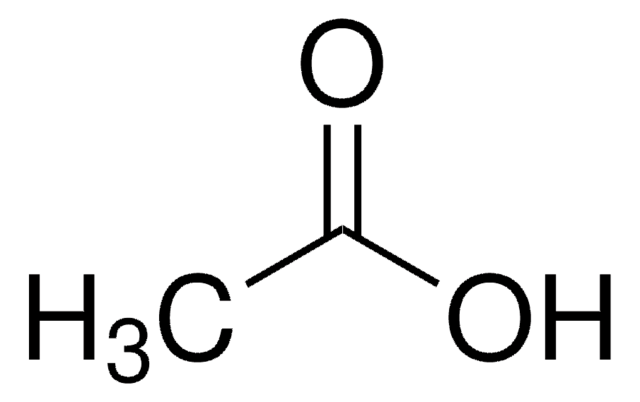1.00066
Acetic acid (glacial)
100%, Suprapur®
Synonym(s):
Acetic acid, Ethanoic acid, Glacial acetic acid
About This Item
Recommended Products
product name
Acetic acid (glacial) 100%, Suprapur®
grade
for inorganic trace analysis
Quality Level
vapor density
2.07 (vs air)
vapor pressure
15.4 hPa ( 20 °C)
assay
≥99.8% (acidimetric)
100%
form
liquid
autoignition temp.
485 °C
800 °F
potency
3310 mg/kg LD50, oral (Rat)
expl. lim.
16 %, 92 °F
4 %, 59 °F
technique(s)
LC/MS: suitable
refractive index
n20/D 1.371 (lit.)
pH
2.5 (20 °C, 50 g/L in H2O)
kinematic viscosity
1.17 cSt(20 °C)
bp
117-118 °C (lit.)
mp
16.2 °C (lit.)
transition temp
flash point 39 °C
solubility
soluble 602.9 g/L
density
1.04 g/mL at 25 °C (lit.)
anion traces
chloride (Cl-): ≤100 ppb
phosphate (PO43-): ≤50 ppb
sulfate (SO42-): ≤400 ppb
cation traces
Ag: ≤1.0 ppb
Al: ≤2.0 ppb
As: ≤0.5 ppb
Au: ≤0.5 ppb
B: ≤0.5 ppb
Ba: ≤0.5 ppb
Be: ≤0.5 ppb
Bi: ≤0.5 ppb
Ca: ≤20.0 ppb
Cd: ≤0.5 ppb
Co: ≤0.5 ppb
Cr: ≤5.0 ppb
Cu: ≤1.0 ppb
Fe: ≤20.0 ppb
Ga: ≤0.5 ppb
Ge: ≤0.5 ppb
Hg: ≤2.0 ppb
In: ≤0.5 ppb
K: ≤2.0 ppb
Li: ≤0.5 ppb
Mg: ≤2.0 ppb
Mn: ≤1.0 ppb
Mo: ≤1.0 ppb
Na: ≤5.0 ppb
Ni: ≤5.0 ppb
Pb: ≤2.0 ppb
Pt: ≤0.5 ppb
Sb: ≤0.5 ppb
Sn: ≤0.5 ppb
Sr: ≤0.5 ppb
Ti: ≤0.5 ppb
Tl: ≤0.5 ppb
V: ≤0.5 ppb
Zn: ≤2.0 ppb
Zr: ≤0.5 ppb
SMILES string
CC(O)=O
storage temp.
2-8°C
InChI
1S/C2H4O2/c1-2(3)4/h1H3,(H,3,4)
InChI key
QTBSBXVTEAMEQO-UHFFFAOYSA-N
Looking for similar products? Visit Product Comparison Guide
Related Categories
Application
- Screening Ultra-Stable (Phenazine)dioxyalkanocic Acids with Varied Water-Solubilizing Chain Lengths for High-Capacity Aqueous Redox Flow Batteries: This study explores the application of phenazine-based compounds, where acetic acid′s derivatives act as soluble mediators in redox flow batteries, offering insights into optimizing battery electrolytes for enhanced capacity and stability (Liu et al., 2024).
- Ambient Aqueous Synthesis of Imine-Linked Covalent Organic Frameworks (COFs) and Fabrication of Freestanding Cellulose Nanofiber@COF Nanopapers: This research demonstrates the use of acetic acid in the eco-friendly synthesis of imine-linked covalent organic frameworks, highlighting its role in promoting green chemistry practices within material science (Kong et al., 2024).
- Green, Safe, and Reliable Synthesis of Bimetallic MOF-808 Nanozymes With Enhanced Aqueous Stability and Reactivity for Biological Applications: Glacial acetic acid is used to modulate the pH during the synthesis of MOF-808 nanozymes, improving their biological compatibility and stability for potential therapeutic applications (Simms et al., 2024).
- Dual-Functional Manganese-Doped ZnO-MOF Hybrid Material with Enhanced Hydrolytic Stability: In this study, acetic acid is integral in the synthesis of a ZnO-based metal-organic framework, enhancing its hydrolytic stability and functionality as a sensor for environmental monitoring (Asadevi et al., 2023).
- Extraction of Nucleotides from Dietary Supplements by Newly Synthesized Adsorbents: The research utilizes acetic acid in the extraction process of nucleotides from dietary supplements, showcasing its efficacy in increasing the yield and purity of extracted compounds (Studzińska et al., 2023).
Analysis Note
Colour: ≤ 5 Hazen
Acetaldehyde: ≤ 2 ppm
Solidification temperature: ≥ 16.3 °C
Chloride (Cl): ≤ 100 ppb
Phosphate (PO₄): ≤ 50 ppb
Sulphate (SO₄): ≤ 400 ppb
Ag (Silver): ≤ 1.0 ppb
Al (Aluminium): ≤ 2.0 ppb
As (Arsenic): ≤ 0.5 ppb
Au (Gold): ≤ 0.5 ppb
B (Boron): ≤ 0.5 ppb
Ba (Barium): ≤ 0.5 ppb
Be (Beryllium): ≤ 0.5 ppb
Bi (Bismuth): ≤ 0.5 ppb
Ca (Calcium): ≤ 20.0 ppb
Cd (Cadmium): ≤ 0.5 ppb
Co (Cobalt): ≤ 0.5 ppb
Cr (Chromium): ≤ 5.0 ppb
Cu (Copper): ≤ 1.0 ppb
Fe (Iron): ≤ 20.0 ppb
Ga (Gallium): ≤ 0.5 ppb
Ge (Germanium): ≤ 0.5 ppb
Hg (Mercury): ≤ 2.0 ppb
In (Indium): ≤ 0.5 ppb
K (Potassium): ≤ 2.0 ppb
Li (Lithium): ≤ 0.5 ppb
Mg (Magnesium): ≤ 2.0 ppb
Mn (Manganese): ≤ 1.0 ppb
Mo (Molybdenum): ≤ 1.0 ppb
Na (Sodium): ≤ 5.0 ppb
Ni (Nickel): ≤ 5.0 ppb
Pb (Lead): ≤ 2.0 ppb
Pt (Platinum): ≤ 0.5 ppb
Sb (Antimony): ≤ 0.5 ppb
Sn (Tin): ≤ 0.5 ppb
Sr (Strontium): ≤ 0.5 ppb
Ti (Titanium): ≤ 0.5 ppb
Tl (Thallium): ≤ 0.5 ppb
V (Vanadium): ≤ 0.5 ppb
Zn (Zinc): ≤ 2.0 ppb
Zr (Zirconium): ≤ 0.5 ppb
Substances reducing potassium dichromate: ≤ 30 ppm
Substances reducing potassium permanganate: ≤ 20 ppm
Residue on ignition (as sulphate): ≤ 2 ppm
The actual values are subject to unavoidable systematic
variations in this concentration range.
Legal Information
signalword
Danger
hcodes
Hazard Classifications
Eye Dam. 1 - Flam. Liq. 3 - Skin Corr. 1A
Storage Class
3 - Flammable liquids
wgk_germany
WGK 1
flash_point_f
102.2 °F
flash_point_c
39 °C
Certificates of Analysis (COA)
Search for Certificates of Analysis (COA) by entering the products Lot/Batch Number. Lot and Batch Numbers can be found on a product’s label following the words ‘Lot’ or ‘Batch’.
Already Own This Product?
Find documentation for the products that you have recently purchased in the Document Library.
Customers Also Viewed
Our team of scientists has experience in all areas of research including Life Science, Material Science, Chemical Synthesis, Chromatography, Analytical and many others.
Contact Technical Service


